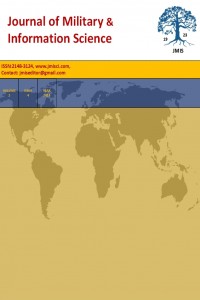Abstract
In the 21st century, unmanned systems (especially unmanned aerial vehicles) will play a dominant role in the operational fields. Thanks to the technological developments witnessed in many fields, the use of unmanned aerial vehicles for military purposes is becoming easier. Looking at the operations carried out over the last 25 years, it can be seen that most were conducted in residential areas, where and techniques, tactics and equipment with asymmetric effects will make significant differences. In addition to this, the more loss of life in operations, the more governments come under pressure from the public. Taking these factors into consideration, it is believed that unmanned aerial vehicles, which can be used to increase dominance in operations and prevent loss of life, will be used more often and more effectively in the future. It is also believed that unmanned aerial vehicles will be used as assault media in both residential areas and in other operational environments in order to take advantage of the high level asymmetric effect.
References
- Drew, J. G., Shaver, R., Lynch, K. F., Amouzegar, M. A., Snyder, D. (2005). Unmanned aerial vehicle end-to-end support considerations. Rand Corporation Santa Monica.
- Eun, Y., Bang, H. (2009). Cooperative Task Assignment/Path Planning of Multiple Unmanned Aerial Vehicles Using Genetic Algorithm. Journal of aircraft, 46(1), 338-343.
- Gertler, J. (2012, January). US unmanned aerial systems. Lıbrary of Congress Washıngton DC Congressıonal Research Servıce.
- Glade, D., (2000) Unmanned aerial vehicles: Implications for military operations, Air University Press Maxwell AFB, Center for Strategy and Technology Air War College, Alabama.
- Haddal, C. C., Gertler, J. (2010, July). Homeland security: Unmanned aerial vehicles and border surveillance. Lıbrary of Congress Washıngton DC Congressıonal Research Servıce.
- Haskologlu, İ., Eker, A. A., & Adana, Ş. (2013). A Perspective of Applications of Unmanned Systems in Asymmetric Warfare. International Journal of Information & Education Technology, 3(6), 656-659.
- Haulman, D. L. (2003). US unmanned aerial vehicles in combat, 1991-2003. Air Force Historical Research Agency Maxwell AFB Alabama.
- John, D. B., Unmanned Aerial Systems: A Historical Perspective, Combat Studied Instıtute Press, US Army Combat Arms Center, Fort Leavenworth, Kansas, 2010, September.
- Kelly, S. K., (2004). Future Capabilities and Roles of Uninhabited Combat Aerial Vehicles (UCAV). Joint Military Operations Department, Naval War College, Newport.
- Lovelace, D. C., Boon, K. (Eds.). (2014). Terrorism: Commentary on Security Documents Volume 133: The Drone Wars of the 21st Century: Costs and Benefits (Vol. 133). Oxford University Press.
- Murray, R. M. (2007). Recent research in cooperative control of multivehicle systems. Journal of Dynamic Systems, Measurement, and Control, 129, 571-583.
- Pardesi, M. S. (2005). Unmanned Aerial Vehicles/Unmanned Combat Aerial Vehicles. Air & Space Power Journal, 45-54.
- Samuel J. B., Sustaining The U.S Lead in Unmanned Systems Military And Homeland Considerations Through 2025, A Report of the CSIS International Security Program 2014, February.
- Steven J.Z., “Increase in Imortance”, Aviation Week & Space Technology, 2004, January 19th, pp.105.
Abstract
References
- Drew, J. G., Shaver, R., Lynch, K. F., Amouzegar, M. A., Snyder, D. (2005). Unmanned aerial vehicle end-to-end support considerations. Rand Corporation Santa Monica.
- Eun, Y., Bang, H. (2009). Cooperative Task Assignment/Path Planning of Multiple Unmanned Aerial Vehicles Using Genetic Algorithm. Journal of aircraft, 46(1), 338-343.
- Gertler, J. (2012, January). US unmanned aerial systems. Lıbrary of Congress Washıngton DC Congressıonal Research Servıce.
- Glade, D., (2000) Unmanned aerial vehicles: Implications for military operations, Air University Press Maxwell AFB, Center for Strategy and Technology Air War College, Alabama.
- Haddal, C. C., Gertler, J. (2010, July). Homeland security: Unmanned aerial vehicles and border surveillance. Lıbrary of Congress Washıngton DC Congressıonal Research Servıce.
- Haskologlu, İ., Eker, A. A., & Adana, Ş. (2013). A Perspective of Applications of Unmanned Systems in Asymmetric Warfare. International Journal of Information & Education Technology, 3(6), 656-659.
- Haulman, D. L. (2003). US unmanned aerial vehicles in combat, 1991-2003. Air Force Historical Research Agency Maxwell AFB Alabama.
- John, D. B., Unmanned Aerial Systems: A Historical Perspective, Combat Studied Instıtute Press, US Army Combat Arms Center, Fort Leavenworth, Kansas, 2010, September.
- Kelly, S. K., (2004). Future Capabilities and Roles of Uninhabited Combat Aerial Vehicles (UCAV). Joint Military Operations Department, Naval War College, Newport.
- Lovelace, D. C., Boon, K. (Eds.). (2014). Terrorism: Commentary on Security Documents Volume 133: The Drone Wars of the 21st Century: Costs and Benefits (Vol. 133). Oxford University Press.
- Murray, R. M. (2007). Recent research in cooperative control of multivehicle systems. Journal of Dynamic Systems, Measurement, and Control, 129, 571-583.
- Pardesi, M. S. (2005). Unmanned Aerial Vehicles/Unmanned Combat Aerial Vehicles. Air & Space Power Journal, 45-54.
- Samuel J. B., Sustaining The U.S Lead in Unmanned Systems Military And Homeland Considerations Through 2025, A Report of the CSIS International Security Program 2014, February.
- Steven J.Z., “Increase in Imortance”, Aviation Week & Space Technology, 2004, January 19th, pp.105.
Details
| Primary Language | English |
|---|---|
| Journal Section | Reports |
| Authors | |
| Publication Date | November 29, 2014 |
| Published in Issue | Year 2014 Volume: 2 Issue: 4 |


